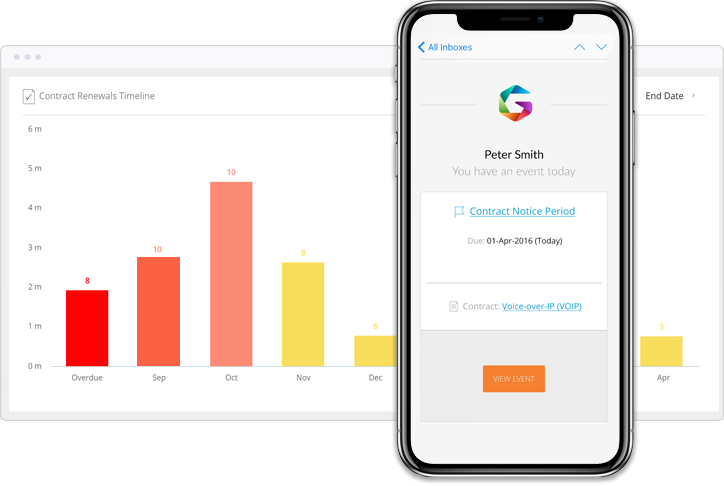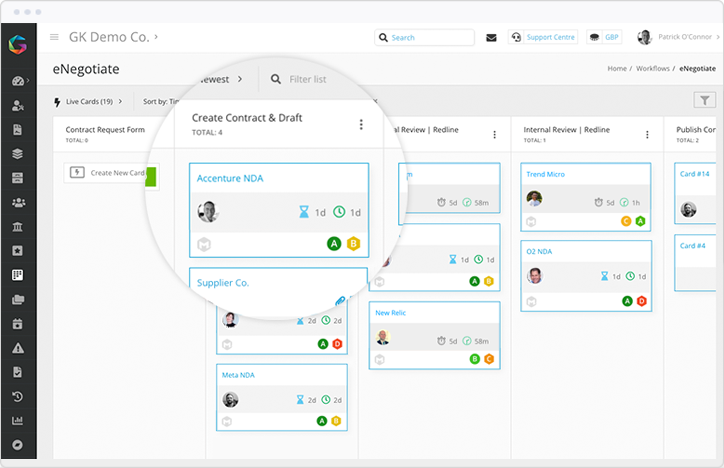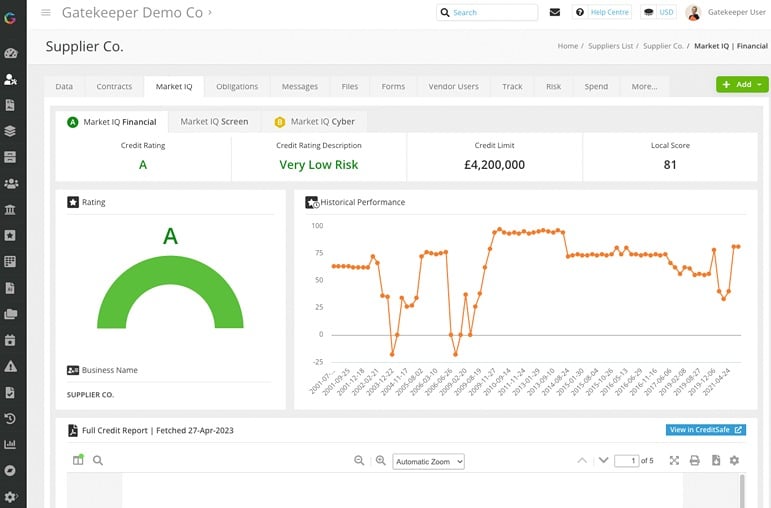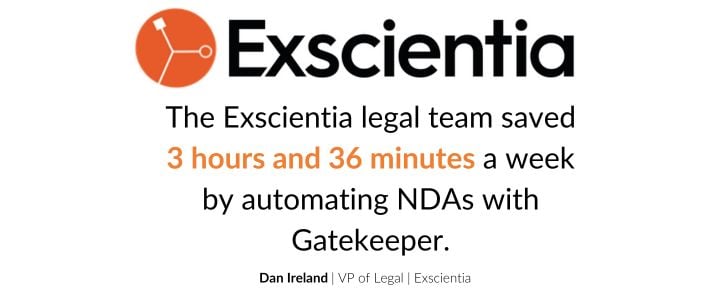Are you still using manual, on-premise solutions for your contract management efforts?
In a world of advancing Artificial Intelligence (AI), sweeping regulatory changes and a focus on digital transformation, your business could face some difficulty without the right technology in place.
In this article, we'll explore:
What is cloud contract management?
Cloud-based contract management vs traditional solutions
How to make the business case for new software
What is the best solution to use?
What is cloud contract management?
Cloud contract management refers to specialised, intuitive Software-as-a-Service (SaaS) platforms such as Gatekeeper to automate the entire lifecycle of contracts. This modern approach eliminates manual, fragmented approaches to contract management - traditionally consisting of spreadsheets, emails and shared drives.
The benefits of Cloud-based contract management vs traditional solutions
Cloud-based contract management software offers significant advantages over traditional methods.
Businesses adopting CLM software can expect to reduce contract lifecycle time to half, reduce administrative overhead by 25%-30%, and improve compliance by 55%, according to Gartner."
Below, we outline some of the most important advantages businesses can experience when they move away from traditional management methods.
| Feature | Cloud-Based Contract Management | Traditional Solutions |
|---|---|---|
| Visibility | High visibility with real-time access to contract statuses and updates. Dashboards and reporting tools provide comprehensive oversight. | Limited visibility due to physical storage and disjointed systems. Access to contract statuses often requires manual retrieval. |
| Control | Enhanced control through centralised management. Features like permission settings and audit trails ensure only authorised access is given and all changes are logged. | Control is more challenging and error-prone due to decentralised and manual handling of contracts. |
| Compliance | Automated compliance checks ensure that all contracts adhere to relevant laws and regulations. Notifications for renewals and expirations prevent compliance lapses. | Compliance relies heavily on manual monitoring, increasing the risk of errors and non-compliance due to oversight or outdated data. |
| Manual Effort | Significantly reduced manual effort due to automation of routine tasks like drafting, reviewing, and approving contracts. | High manual effort required for all stages of contract management, from drafting to storage and retrieval. |
| Scalability | Easily scalable to accommodate growing numbers of contracts and users without significant additional costs. Systems can expand seamlessly as business needs evolve. | Scaling requires physical space and additional resources, which can be costly and slow to implement. |
| Cost-Effectiveness | More cost-effective in the long run due to lower maintenance costs, no need for physical storage solutions, and reduced staffing requirements for manual tasks. | Higher ongoing costs related to physical storage, maintenance, and the manpower needed to manage contracts manually. |
| Integration | Easily integrates with other business systems (e.g., ERP, CRM) for better data coherence and workflow continuity. APIs facilitate smooth data exchange across platforms. | Integration is limited and often cumbersome, requiring manual data entry and leading to potential data silos and inconsistencies. |
| Security | Advanced security protocols such as encryption and secure cloud storage protect sensitive contract data. Regular updates ensure the latest security measures are in place. | Security depends on physical controls and local IT capabilities, which may be less robust and more susceptible to risks like theft. |
| Access | Accessible from anywhere at any time, which is crucial for remote teams and modern, flexible working environments. | Access is generally restricted to office locations, posing challenges for remote access and flexibility in working arrangements. |
How to build a business Case for Cloud Contract Management
Having a contract management solution hosted in the cloud helps solve two of the most common issues associated with contract management:
- Centralisation of data
- Accessibility of data
This resolution provides benefits such as better visibility over renewals, compliance gaps and risk identification. Yet there are common objections and concerns, especially from stakeholders in regulated industries such as finance, healthcare, and pharma businesses.
These concerns can include:
- Security and Data Privacy: The perceived risk of storing sensitive or proprietary data on servers outside the company's direct control can be a major hurdle. There is anxiety about breaches, unauthorised access, and the potential for data loss
- Compliance with Regulations: Regulated industries are subject to strict data protection and privacy regulations. Companies often worry whether cloud providers can consistently comply with relevant laws and industry standards, such as GDPR, HIPAA, or Sarbanes-Oxley.
- Loss of Control: There is a fear that outsourcing data storage and management to a third party reduces the company's control over its own information and processes.
- Reliability and Performance Issues: Potential downtime and the performance of cloud-based systems can be a concern, with worries about internet dependency and the impact of system failures on access to critical data.
As part of your business case, you must demonstrate how a potential solution, such as Gatekeeper can alleviate these concerns.
Features and benefits that will appeal to your stakeholders may include
- Industry-leading encryption methods for data at rest and in transit, alongside rigorous compliance with global security standards including ISO27001 and SOC2.
- Compliance with major regulatory frameworks like GDPR, HIPAA, and others, offering features such as automated compliance checks and audit trails.
- Comprehensive access controls and permissions, allowing administrators to tightly manage who can see and edit various types of data and documents.
- Regularly maintained updated infrastructure, securing the system against vulnerabilities whilst optimising its performance.
What is the best CLM solution to use?
Gatekeeper offers a comprehensive cloud-based vendor and contract management solution tailored to meet the unique needs of regulated industries.
Visibility wherever you are
Access unparalleled visibility into your contract portfolio, offering real-time, secure access to contract statuses and updates from any device or location.
With intuitive dashboards and robust reporting tools, you can effortlessly track contract performance, monitor key milestones, and gain actionable insights to drive informed decision-making.
Gatekeeper puts critical information at your fingertips, empowering you to stay ahead in a dynamic business environment.

Centralised Control for Efficiency and Security
Gatekeeper offers centralised management features, including customisable permission settings and comprehensive audit trails.
Ensure that only authorised users can access sensitive contract data while maintaining a clear record of all activities, so you can always be audit-ready.
With the Kanban Engine, visual dashboards and 24/7 monitoring of your vendor base, you can always stay in control. There is no compromise just because you're in the cloud.

Compliance made easy
Market IQ streamlines compliance monitoring with automated checks tailored to your industry's specific regulations.
Whether it's financial, security, or industry-specific mandates, Market IQ continuously scans contracts, flagging potential compliance issues and providing proactive alerts for timely action.
Cloud-based contract management software is designed to make life easier.

Conclusion
By using a cloud-based contract management system, your organisation can improve efficiency, reduce manual effort, and heighten data security. With data accessible from anywhere and anytime, cloud-based CLM solutions empower your team to work more collaboratively and make data-driven decisions.
Now is the time to embrace the future of contract management. Spreadsheets will only hold you back. Take the first step towards transformation by booking a demo with Gatekeeper today.




.png)
.png)
.png)
-4.png)